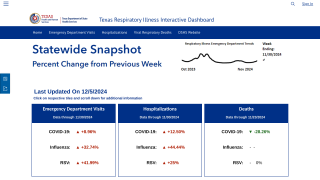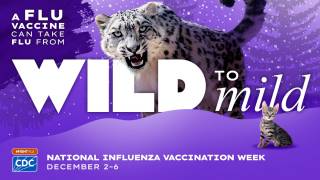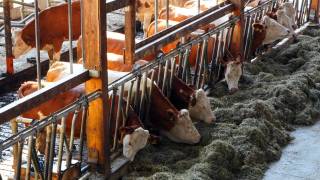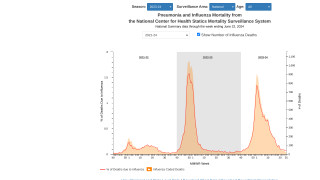Northern Hemisphere Flu News for 2020

As most of the Northern Hemisphere was celebrating the arrival of the New Year, many areas started to report increasing rates of influenza virus, according to the latest global flu update published by the World Health Organization (WHO).
On January 6, 2020, the WHO reported seasonal influenza A(H3N2) viruses accounted for the majority of detections around the globe.
In the temperate zones of the Northern Hemisphere respiratory illness indicators and influenza activity continued to increase, such as the following.
In the countries of North America, Influenza-Like-Illnesses (ILI) and influenza activity further increased:
- All seasonal influenza subtypes co-circulate in Canada and the United States of America (USA), though the proportion of influenza B viruses was higher than in previous years for this period of the influenza season.
- Influenza B viruses accounted for half of the detections in Canada and influenza B/Victoria viruses were the predominant influenza type detected in the US, followed by influenza A(H1N1)pdm09.
- In Canada, the percentage of visits for ILI and pediatric hospitalizations increased and followed the average trend of previous seasons. For this season the majority of hospitalizations were associated with influenza A(H3N2). However, among sentinel pediatric hospitalizations with influenza, Influenza update approximately 55% were associated with influenza B.
- In the USA, ILI activity raised sharply in the last weeks and reached the peak level of last influenza season. Hospitalization rates were similar to those reported during recent seasons. The percentage of deaths attributed to pneumonia and influenza increased but remained below the epidemic threshold.
- Sixteen of the 22 influenza-associated pediatric deaths reported in the USA were associated with influenza B viruses.
In Europe, influenza activity continued to increase across the region:
- In Northern Europe, influenza detections and syndromic surveillance indicators increased. Influenza A detections predominated in most reporting countries. Among the subtyped influenza A detections, influenza A(H3N2) predominated in Ireland and the United Kingdom of Great Britain and Northern Ireland (United Kingdom) while both influenza A(H1N1)pdm09 and A(H3N2) were reported in Finland and Iceland.
- In Ireland, ILI activity was reported at moderate levels; in the United Kingdom, ILI activity was moderate in Northern Ireland and Wales, low in England and below baseline in Scotland in week 50.
- In England, influenza hospitalizations and admissions to Intensive Care Units were at mid-levels. Respiratory syncytial virus activity increased in England and was reported as high in Ireland.
- In Eastern and Southwestern Europe, influenza detections increased but remained low with influenza A and B viruses reported. Syndromic surveillance indicators increased following seasonal trends but were generally low.
In Central Asia, influenza activity increased with influenza A and B viruses co-circulating in all reporting countries except Uzbekistan where only influenza B viruses were reported:
- In Northern Africa, influenza activity was low overall, though Morocco and Tunisia reported influenza B virus detections in recent weeks.
- In Western Asia, influenza activity remained elevated overall. Influenza activity continued to increase in Iraq, Israel, Jordan, Turkey, and Yemen, with detections of predominately influenza A(H1N1)pdm09 and a small proportion of B viruses (except in Yemen reporting predominantly influenza A(H1N1)pdm09).
- In Bahrain, influenza activity remained elevated with all seasonal influenza subtypes co-circulating. Detections of predominantly influenza B/Victoria lineage were reported as slightly increased in Lebanon.
- In Oman, Qatar and Saudi Arabia, influenza activity was reported as decreased with co-circulation of influenza A and B viruses.
- In East Asia, ILI and influenza activity continued to increase overall. In China, ILI activity continued to increase and was slightly earlier and higher than the levels of the three previous seasons; influenza activity also increased, with detections of predominately influenza A(H3N2), followed by a smaller proportion of influenza B/Victoria lineage viruses.
- In Mongolia, respiratory illness indicators were above the seasonal threshold with increased detections of influenza B viruses reported. In the Republic of Korea, ILI and influenza activity continued to increase with influenza A(H1N1)pdm09 and A(H3N2) viruses co-circulating.
- In Japan, influenza activity was detected slightly earlier than in previous seasons, with a continued increase in the number of influenza cases per sentinel site.
In related flu news, the following studies offered new insights:
- January 7, 2020 – A new study from Australia revealed influenza vaccinations were 31 percent effective in reducing mortality for hospital-related flu cases.
- December 31, 2019 – The UK’s Joint Committee on Vaccination and Immunisation recently issued advice on vaccines in the National Health Service annual seasonal flu vaccination program and reimbursement guidance for 2020-2021 flu season.
- December 27, 2019 – The CDC FluView report confirmed there have been 16 pediatric fatalities associated with influenza B viruses during the 2019-2020 flu season. And, 5 of these 16 fatalities had the lineage determined and all were B/Victoria viruses.
The US Centers for Disease Control and Prevention (CDC) says ‘everyone 6 months of age and older should get a flu vaccine every season with rare exceptions. And, suggests patients discuss their vaccination options with a licensed healthcare provider.’
A more detailed explanation of the flu burden and burden averted by seasonal flu vaccines during 2019-2020 are available from CDC’s Flu Burden page.
Flu vaccine news is published by Precision Vaccinations.
Our Trust Standards: Medical Advisory Committee
























